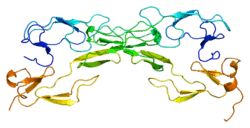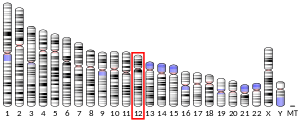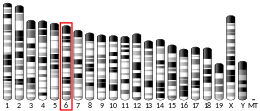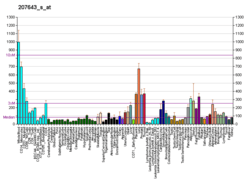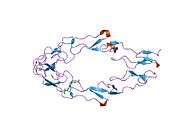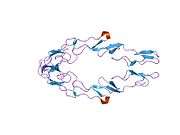Tumor necrosis factor receptor 1
Tumor necrosis factor receptor 1 (TNFR1), also known as tumor necrosis factor receptor superfamily member 1A (TNFRSF1A) and CD120a, is a ubiquitous membrane receptor that binds tumor necrosis factor-alpha (TNFα).[5][6][7]
Function
The protein encoded by this gene is a member of the tumor necrosis factor receptor superfamily, which also contains TNFRSF1B. This protein is one of the major receptors for the tumor necrosis factor-alpha. This receptor can activate the transcription factor NF-κB, mediate apoptosis, and function as a regulator of inflammation. Antiapoptotic protein BCL2-associated athanogene 4 (BAG4/SODD) and adaptor proteins TRADD and TRAF2 have been shown to interact with this receptor, and thus play regulatory roles in the signal transduction mediated by the receptor.[8]
Clinical significance
Germline mutations of the extracellular domains of this receptor were found to be associated with the human genetic disorder called tumor necrosis factor associated periodic syndrome (TRAPS) or periodic fever syndrome.[9] Impaired receptor clearance is thought to be a mechanism of the disease.
Mutations in the TNFRSF1A gene are associated with elevated risk of multiple sclerosis.[10]
Serum levels of TNFRSF1A are elevated in schizophrenia and bipolar disorder,[11] and high levels are associated with more severe psychotic symptoms.[12]
High serum levels are also associated with cognitive impairment and dementia.[13][14]
Interactions
TNFRSF1A has been shown to interact with:
References
- GRCh38: Ensembl release 89: ENSG00000067182 - Ensembl, May 2017
- GRCm38: Ensembl release 89: ENSMUSG00000030341 - Ensembl, May 2017
- "Human PubMed Reference:". National Center for Biotechnology Information, U.S. National Library of Medicine.
- "Mouse PubMed Reference:". National Center for Biotechnology Information, U.S. National Library of Medicine.
- Baker E, Chen LZ, Smith CA, Callen DF, Goodwin R, Sutherland GR (November 1991). "Chromosomal location of the human tumor necrosis factor receptor genes". Cytogenet Cell Genet. 57 (2–3): 117–8. doi:10.1159/000133127. PMID 1655358.
- Schall TJ, Lewis M, Koller KJ, Lee A, Rice GC, Wong GH, Gatanaga T, Granger GA, Lentz R, Raab H, et al. (June 1990). "Molecular cloning and expression of a receptor for human tumor necrosis factor". Cell. 61 (2): 361–70. doi:10.1016/0092-8674(90)90816-W. PMID 2158863.
- Offermanns, Stefan; Rosenthal, Walter (2008). Encyclopedia of Molecular Pharmacology, Vol. 1 (2nd ed.). Heidelberg, Germany: Springer. p. 1248. ISBN 9783540389163.
- "Entrez Gene: TNFRSF1A tumor necrosis factor receptor superfamily, member 1A".
- Kümpfel T, Hohlfeld R (October 2009). "Multiple sclerosis. TNFRSF1A, TRAPS and multiple sclerosis". Nat Rev Neurol. 5 (10): 528–9. doi:10.1038/nrneurol.2009.154. PMID 19794511.
- International Multiple Sclerosis Genetics Consortium (2011). "The genetic association of variants in CD6, TNFRSF1A and IRF8 to multiple sclerosis: a multicenter case-control study". PLoS ONE. 6 (4): e18813. doi:10.1371/journal.pone.0018813. PMC 3084233. PMID 21552549.
- Hope S, Melle I, Aukrust P, Steen NE, Birkenaes AB, Lorentzen S, Agartz I, Ueland T, Andreassen OA (November 2009). "Similar immune profile in bipolar disorder and schizophrenia: selective increase in soluble tumor necrosis factor receptor I and von Willebrand factor". Bipolar Disord. 11 (7): 726–34. doi:10.1111/j.1399-5618.2009.00757.x. hdl:10852/34620. PMID 19839997.
- Hope S, Ueland T, Steen NE, Dieset I, Lorentzen S, Berg AO, Agartz I, Aukrust P, Andreassen OA (April 2013). "Interleukin 1 receptor antagonist and soluble tumor necrosis factor receptor 1 are associated with general severity and psychotic symptoms in schizophrenia and bipolar disorder". Schizophr. Res. 145 (1–3): 36–42. doi:10.1016/j.schres.2012.12.023. PMID 23403415.
- Buchhave P, Zetterberg H, Blennow K, Minthon L, Janciauskiene S, Hansson O (November 2010). "Soluble TNF receptors are associated with Aβ metabolism and conversion to dementia in subjects with mild cognitive impairment". Neurobiol. Aging. 31 (11): 1877–84. doi:10.1016/j.neurobiolaging.2008.10.012. PMID 19070941.
- Diniz BS, Teixeira AL, Ojopi EB, Talib LL, Mendonça VA, Gattaz WF, Forlenza OV (2010). "Higher serum sTNFR1 level predicts conversion from mild cognitive impairment to Alzheimer's disease". J. Alzheimers Dis. 22 (4): 1305–11. doi:10.3233/JAD-2010-100921. PMID 20930310.
- Jiang Y, Woronicz JD, Liu W, Goeddel DV (1999). "Prevention of constitutive TNF receptor 1 signaling by silencer of death domains". Science. 283 (5401): 543–6. doi:10.1126/science.283.5401.543. PMID 9915703.
- Miki K, Eddy EM (2002). "Tumor necrosis factor receptor 1 is an ATPase regulated by silencer of death domain". Mol. Cell. Biol. 22 (8): 2536–43. doi:10.1128/MCB.22.8.2536-2543.2002. PMC 133739. PMID 11909948.
- Gajate C, Mollinedo F (2005). "Cytoskeleton-mediated death receptor and ligand concentration in lipid rafts forms apoptosis-promoting clusters in cancer chemotherapy". J. Biol. Chem. 280 (12): 11641–7. doi:10.1074/jbc.M411781200. PMID 15659383.
- Vincenz C, Dixit VM (1997). "Fas-associated death domain protein interleukin-1beta-converting enzyme 2 (FLICE2), an ICE/Ced-3 homologue, is proximally involved in CD95- and p55-mediated death signaling". J. Biol. Chem. 272 (10): 6578–83. doi:10.1074/jbc.272.10.6578. PMID 9045686.
- Hsu H, Shu HB, Pan MG, Goeddel DV (1996). "TRADD-TRAF2 and TRADD-FADD interactions define two distinct TNF receptor 1 signal transduction pathways". Cell. 84 (2): 299–308. doi:10.1016/S0092-8674(00)80984-8. PMID 8565075.
- Zhang SQ, Kovalenko A, Cantarella G, Wallach D (2000). "Recruitment of the IKK signalosome to the p55 TNF receptor: RIP and A20 bind to NEMO (IKKgamma) upon receptor stimulation". Immunity. 12 (3): 301–11. doi:10.1016/S1074-7613(00)80183-1. PMID 10755617.
- Chaudhary PM, Eby MT, Jasmin A, Kumar A, Liu L, Hood L (2000). "Activation of the NF-kappaB pathway by caspase 8 and its homologs". Oncogene. 19 (39): 4451–60. doi:10.1038/sj.onc.1203812. PMID 11002417.
- Guo D, Dunbar JD, Yang CH, Pfeffer LM, Donner DB (1998). "Induction of Jak/STAT signaling by activation of the type 1 TNF receptor". J. Immunol. 160 (6): 2742–50. PMID 9510175.
- Miscia S, Marchisio M, Grilli A, Di Valerio V, Centurione L, Sabatino G, Garaci F, Zauli G, Bonvini E, Di Baldassarre A (2002). "Tumor necrosis factor alpha (TNF-alpha) activates Jak1/Stat3-Stat5B signaling through TNFR-1 in human B cells". Cell Growth Differ. 13 (1): 13–8. PMID 11801527.
- Castellino AM, Parker GJ, Boronenkov IV, Anderson RA, Chao MV (1997). "A novel interaction between the juxtamembrane region of the p55 tumor necrosis factor receptor and phosphatidylinositol-4-phosphate 5-kinase". J. Biol. Chem. 272 (9): 5861–70. doi:10.1074/jbc.272.9.5861. PMID 9038203.
- Boldin MP, Mett IL, Wallach D (1995). "A protein related to a proteasomal subunit binds to the intracellular domain of the p55 TNF receptor upstream to its 'death domain'". FEBS Lett. 367 (1): 39–44. doi:10.1016/0014-5793(95)00534-G. PMID 7601280.
- Dunbar JD, Song HY, Guo D, Wu LW, Donner DB (1997). "Two-hybrid cloning of a gene encoding TNF receptor-associated protein 2, a protein that interacts with the intracellular domain of the type 1 TNF receptor: identity with subunit 2 of the 26S protease". J. Immunol. 158 (9): 4252–9. PMID 9126987.
- Hsu H, Huang J, Shu HB, Baichwal V, Goeddel DV (1996). "TNF-dependent recruitment of the protein kinase RIP to the TNF receptor-1 signaling complex". Immunity. 4 (4): 387–96. doi:10.1016/S1074-7613(00)80252-6. PMID 8612133.
- Kim JW, Choi EJ, Joe CO (2000). "Activation of death-inducing signaling complex (DISC) by pro-apoptotic C-terminal fragment of RIP". Oncogene. 19 (39): 4491–9. doi:10.1038/sj.onc.1203796. PMID 11002422.
- Duan H, Dixit VM (1997). "RAIDD is a new 'death' adaptor molecule" (PDF). Nature. 385 (6611): 86–9. doi:10.1038/385086a0. hdl:2027.42/62739. PMID 8985253.
- Blankenship JW, Varfolomeev E, Goncharov T, Fedorova AV, Kirkpatrick DS, Izrael-Tomasevic A, Phu L, Arnott D, Aghajan M, Zobel K, Bazan JF, Fairbrother WJ, Deshayes K, Vucic D (2009). "Ubiquitin binding modulates IAP antagonist-stimulated proteasomal degradation of c-IAP1 and c-IAP2(1)". Biochem. J. 417 (1): 149–60. doi:10.1042/BJ20081885. PMID 18939944.
- Newton K, Matsumoto ML, Wertz IE, Kirkpatrick DS, Lill JR, Tan J, Dugger D, Gordon N, Sidhu SS, Fellouse FA, Komuves L, French DM, Ferrando RE, Lam C, Compaan D, Yu C, Bosanac I, Hymowitz SG, Kelley RF, Dixit VM (2008). "Ubiquitin chain editing revealed by polyubiquitin linkage-specific antibodies". Cell. 134 (4): 668–78. doi:10.1016/j.cell.2008.07.039. PMID 18724939.
- Varfolomeev E, Goncharov T, Fedorova AV, Dynek JN, Zobel K, Deshayes K, Fairbrother WJ, Vucic D (2008). "c-IAP1 and c-IAP2 are critical mediators of tumor necrosis factor alpha (TNFalpha)-induced NF-kappaB activation". J. Biol. Chem. 283 (36): 24295–9. doi:10.1074/jbc.C800128200. PMC 3259840. PMID 18621737.
- Liou ML, Liou HC (1999). "The ubiquitin-homology protein, DAP-1, associates with tumor necrosis factor receptor (p60) death domain and induces apoptosis". J. Biol. Chem. 274 (15): 10145–53. doi:10.1074/jbc.274.15.10145. PMID 10187798.
- Okura T, Gong L, Kamitani T, Wada T, Okura I, Wei CF, Chang HM, Yeh ET (1996). "Protection against Fas/APO-1- and tumor necrosis factor-mediated cell death by a novel protein, sentrin". J. Immunol. 157 (10): 4277–81. PMID 8906799.
- Shu HB, Takeuchi M, Goeddel DV (1996). "The tumor necrosis factor receptor 2 signal transducers TRAF2 and c-IAP1 are components of the tumor necrosis factor receptor 1 signaling complex". Proc. Natl. Acad. Sci. U.S.A. 93 (24): 13973–8. doi:10.1073/pnas.93.24.13973. PMC 19479. PMID 8943045.
- Schütze S, Machleidt T, Adam D, Schwandner R, Wiegmann K, Kruse ML, Heinrich M, Wickel M, Krönke M (1999). "Inhibition of receptor internalization by monodansylcadaverine selectively blocks p55 tumor necrosis factor receptor death domain signaling". J. Biol. Chem. 274 (15): 10203–12. doi:10.1074/jbc.274.15.10203. PMID 10187805.
- Pan G, O'Rourke K, Chinnaiyan AM, Gentz R, Ebner R, Ni J, Dixit VM (1997). "The receptor for the cytotoxic ligand TRAIL". Science. 276 (5309): 111–3. doi:10.1126/science.276.5309.111. PMID 9082980.
- Soond SM, Terry JL, Colbert JD, Riches DW (2003). "TRUSS, a novel tumor necrosis factor receptor 1 scaffolding protein that mediates activation of the transcription factor NF-kappaB". Mol. Cell. Biol. 23 (22): 8334–44. doi:10.1128/MCB.23.22.8334-8344.2003. PMC 262424. PMID 14585990.
- Bouwmeester T, Bauch A, Ruffner H, Angrand PO, Bergamini G, Croughton K, Cruciat C, Eberhard D, Gagneur J, Ghidelli S, Hopf C, Huhse B, Mangano R, Michon AM, Schirle M, Schlegl J, Schwab M, Stein MA, Bauer A, Casari G, Drewes G, Gavin AC, Jackson DB, Joberty G, Neubauer G, Rick J, Kuster B, Superti-Furga G (2004). "A physical and functional map of the human TNF-alpha/NF-kappa B signal transduction pathway". Nat. Cell Biol. 6 (2): 97–105. doi:10.1038/ncb1086. PMID 14743216.
- Barnhart BC, Peter ME (2003). "The TNF receptor 1: a split personality complex". Cell. 114 (2): 148–50. doi:10.1016/s0092-8674(03)00561-0. PMID 12887914.
- Saltzman A, Searfoss G, Marcireau C, Stone M, Ressner R, Munro R, Franks C, D'Alonzo J, Tocque B, Jaye M, Ivashchenko Y (1998). "hUBC9 associates with MEKK1 and type I TNF-alpha receptor and stimulates NFkappaB activity". FEBS Lett. 425 (3): 431–5. doi:10.1016/S0014-5793(98)00287-7. PMID 9563508.
Further reading
- Rath PC, Aggarwal BB (2000). "TNF-induced signaling in apoptosis". J. Clin. Immunol. 19 (6): 350–64. doi:10.1023/A:1020546615229. PMID 10634209.
- Chen G, Goeddel DV (2002). "TNF-R1 signaling: a beautiful pathway". Science. 296 (5573): 1634–5. doi:10.1126/science.1071924. PMID 12040173.
- Kollias G, Kontoyiannis D (2003). "Role of TNF/TNFR in autoimmunity: specific TNF receptor blockade may be advantageous to anti-TNF treatments". Cytokine Growth Factor Rev. 13 (4–5): 315–21. doi:10.1016/S1359-6101(02)00019-9. PMID 12220546.
- Dodé C, Cuisset L, Delpech M, Grateau G (2003). "TNFRSF1A-associated periodic syndrome (TRAPS), Muckle-Wells syndrome (MWS) and renal amyloidosis". J. Nephrol. 16 (3): 435–7. PMID 12832748.
- Stojanov S, McDermott MF (2007). "The tumour necrosis factor receptor-associated periodic syndrome: current concepts". Expert Reviews in Molecular Medicine. 7 (22): 1–18. doi:10.1017/S1462399405009749. PMID 16216134.
- Rezaei N (2007). "TNF-receptor-associated periodic syndrome (TRAPS): an autosomal dominant multisystem disorder". Clin. Rheumatol. 25 (6): 773–7. doi:10.1007/s10067-005-0198-6. PMID 16447098.
External links
- TNFRSF1A+protein,+human at the US National Library of Medicine Medical Subject Headings (MeSH)
- Overview of all the structural information available in the PDB for UniProt: P19438 (Tumor necrosis factor receptor superfamily member 1A) at the PDBe-KB.
This article incorporates text from the United States National Library of Medicine, which is in the public domain.
